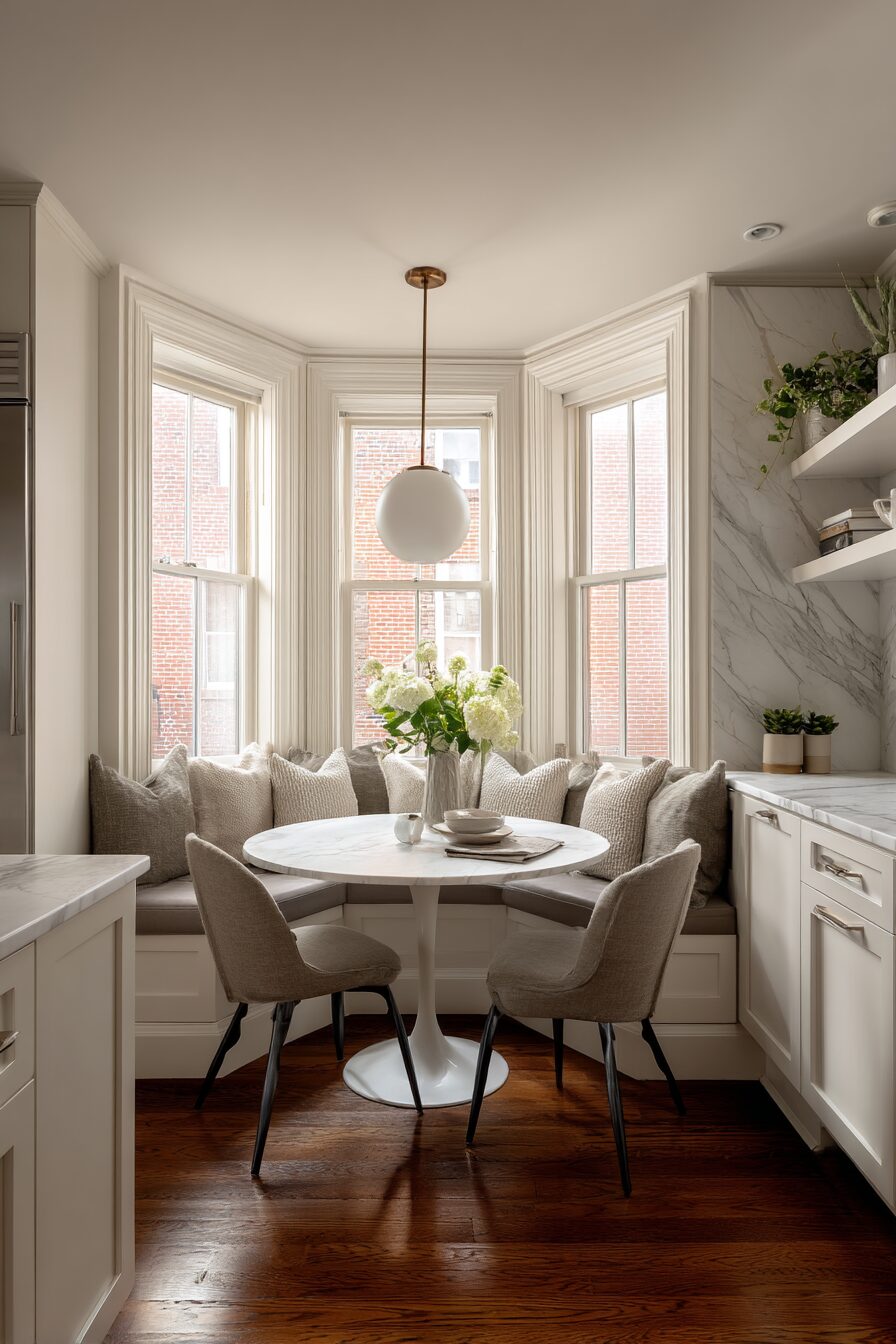In a world of sleek minimalism and high-tech gadgets, there’s something undeniably magical about stepping into a country cottage kitchen that wraps you in warmth and nostalgia.
The gentle clink of ceramic mugs, the scent of fresh-baked bread, and the soft glow of sunlight through gingham curtains—these kitchens aren’t just cooking spaces, they’re sanctuaries of comfort and joy.
Ready to transform your own kitchen into a charming countryside retreat that combines rustic appeal with practical functionality?
✨Click to Get My 101 FREE Designer Room Ideas
Farmhouse Sinks That Tell a Story
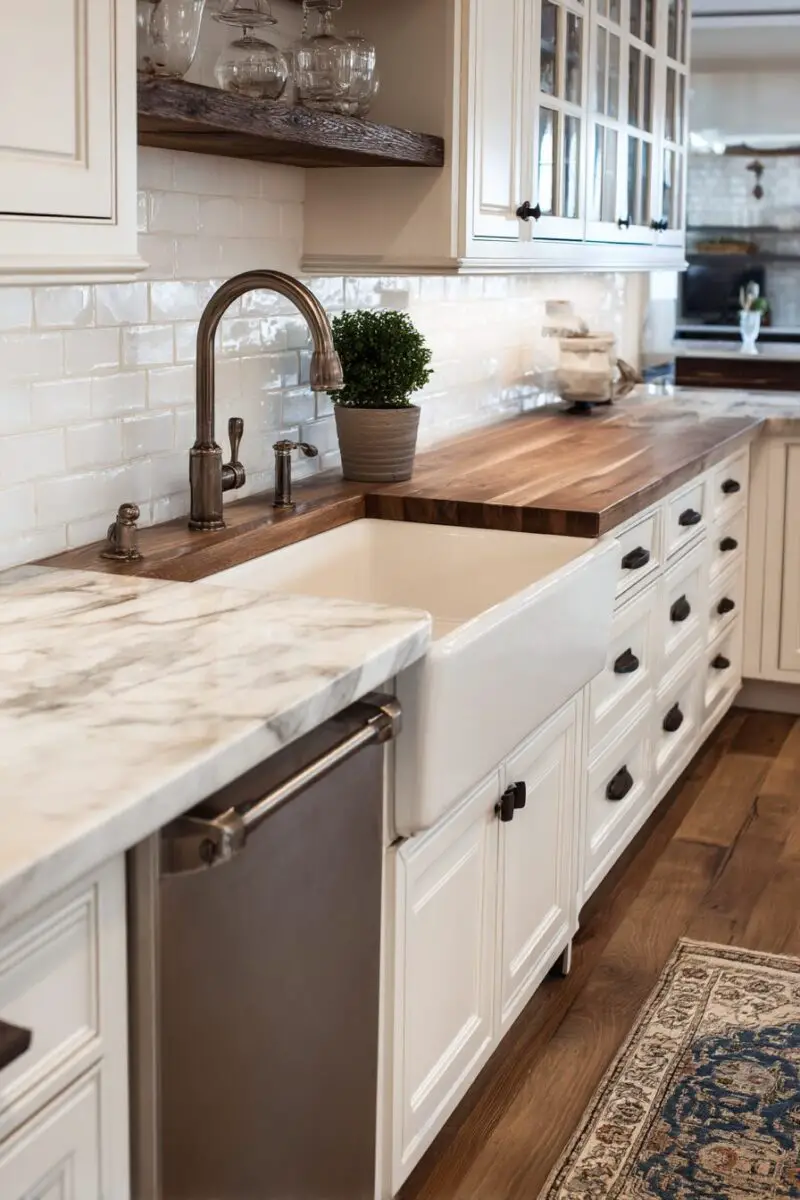
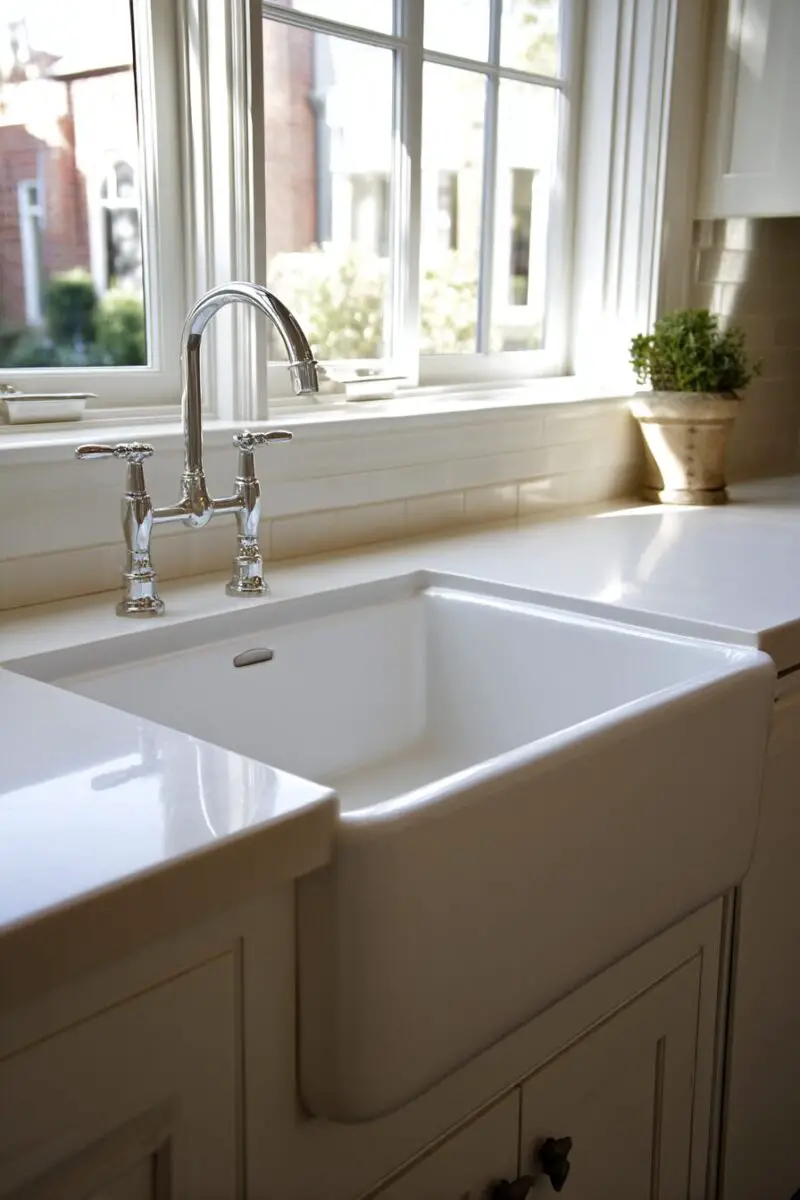
Nothing says country cottage quite like a deep, wide farmhouse sink nestled beneath a window with a view.
These iconic fixtures aren’t just practical workhorses—they’re the heart of a cottage kitchen, offering both vintage appeal and modern functionality.
For authentic charm, consider a classic white fireclay sink with a fluted front that brings immediate character to your space.
The generous single basin design allows for washing everything from garden-fresh produce to your largest roasting pans with ease.
For a more weathered look, explore copper or hammered metal versions that develop a beautiful patina over time, telling the story of your family’s gatherings through years of loving use.
When installing your farmhouse sink, pair it with bridge-style faucets in brushed brass or oil-rubbed bronze for that perfect period feel.
Position the sink beneath a window where possible, allowing you to gaze out at nature while tackling the dishes—a small joy that transforms a daily chore into a meditative moment.
Complete the look with vintage-inspired dish towels draped casually over the edge and a small potted herb plant nearby to bring life to this hardworking area.
Remember that farmhouse sinks sit slightly forward of standard cabinetry, creating a focal point that draws the eye immediately upon entering your kitchen.
This architectural detail, combined with decorative molding around the sink cabinet, elevates the entire room’s design while maintaining that unfussy country appeal that makes cottage kitchens so inviting.
For extra functionality, consider adding a small brass rail along the backsplash above your sink for hanging frequently used tools, keeping them within reach while adding another layer of visual interest to your charming workspace.
Open Shelving That Showcases Beloved Treasures
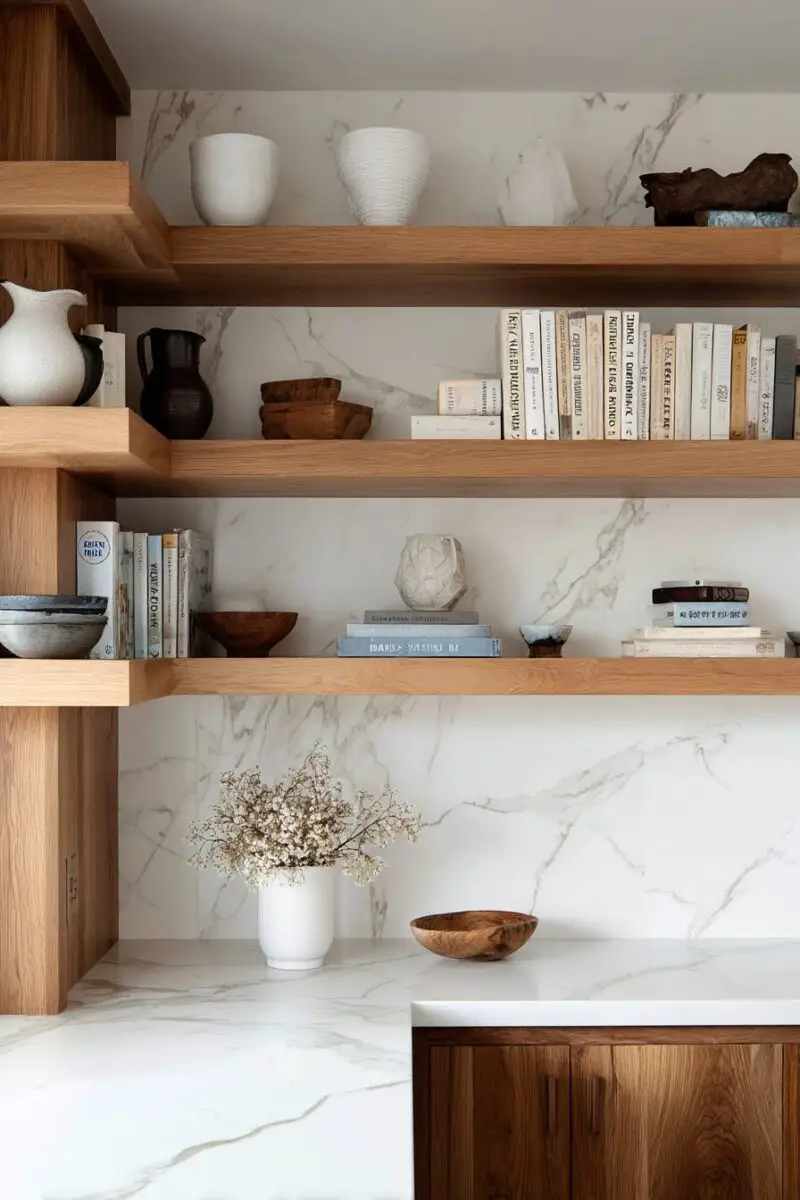
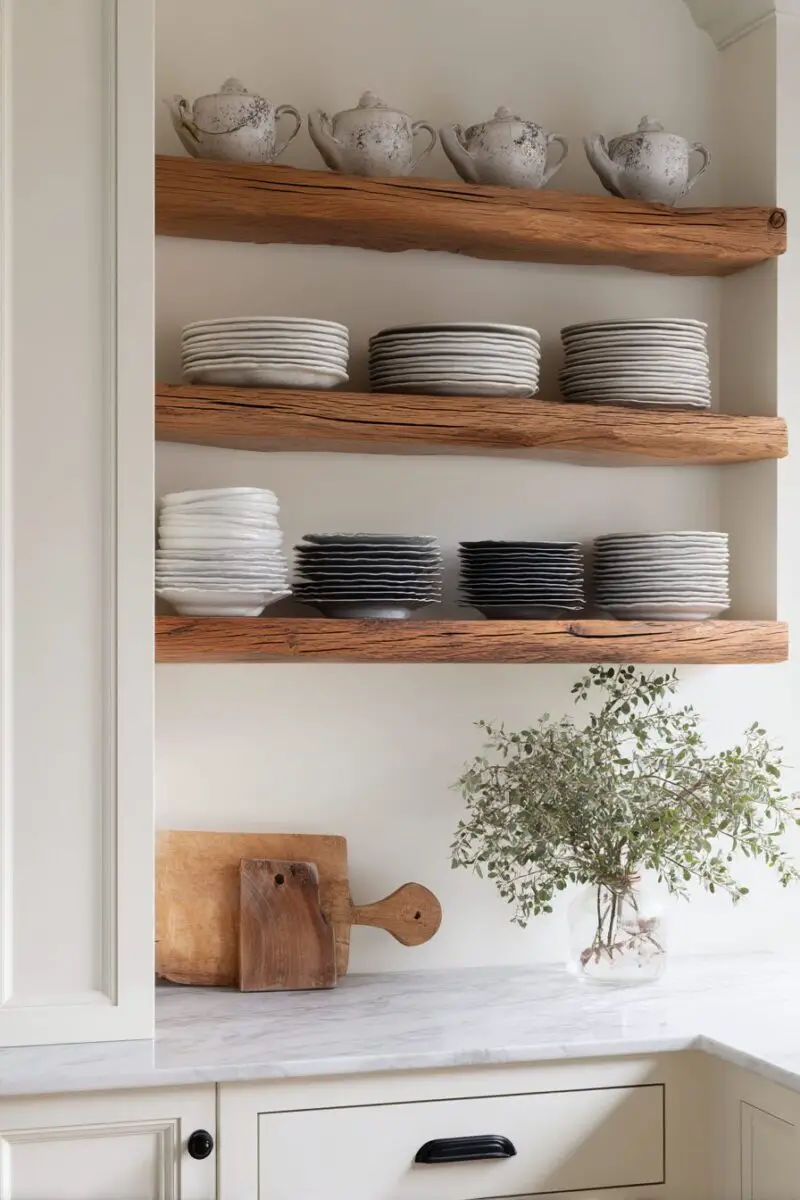
Forget hidden cabinets—country cottage kitchens invite you to display your cherished collections on beautiful open shelving.
This practical approach to storage transforms everyday items into decorative elements that infuse your kitchen with personality and warmth.
Begin with simple wooden shelves in natural finishes or painted in soft, heritage colors that complement your overall palette.
Bracket styles matter—choose ornate cast iron supports for Victorian-inspired cottages or simpler wooden brackets for a more rustic farmhouse feel.
When arranging your shelves, consider a mix of heights to accommodate everything from petite teacups to taller pitchers and vases.
The beauty of open shelving lies in the artful arrangement of items that are both functional and beautiful—stack your grandmother’s transferware plates alongside everyday white dishes for a display that’s visually interesting yet practical.
Mason jars filled with pantry staples like flour, sugar, and rice add both convenience and that quintessential cottage charm when lined up in neat rows.
Don’t be afraid to incorporate sentimental pieces—the teapot from a beloved aunt, hand-thrown pottery from local artisans, or vintage cookbooks with well-worn pages all tell your unique story.
For a truly authentic country cottage look, mix in small potted herbs or trailing plants between kitchen items, bringing life and a connection to nature into your culinary space.
Seasonal adjustments keep your open shelving fresh and engaging—swap in preserved autumn leaves in small vases during fall or bright citrus fruits in wooden bowls during summer months.
Lighting makes all the difference with open shelving—consider small sconce lights mounted between shelves or a string of delicate fairy lights to illuminate your collections during evening hours.
Remember that the most charming cottage shelves balance beauty with practicality—keep frequently used items within easy reach while positioning more decorative pieces at higher levels.
Vintage-Inspired Appliances With Modern Convenience
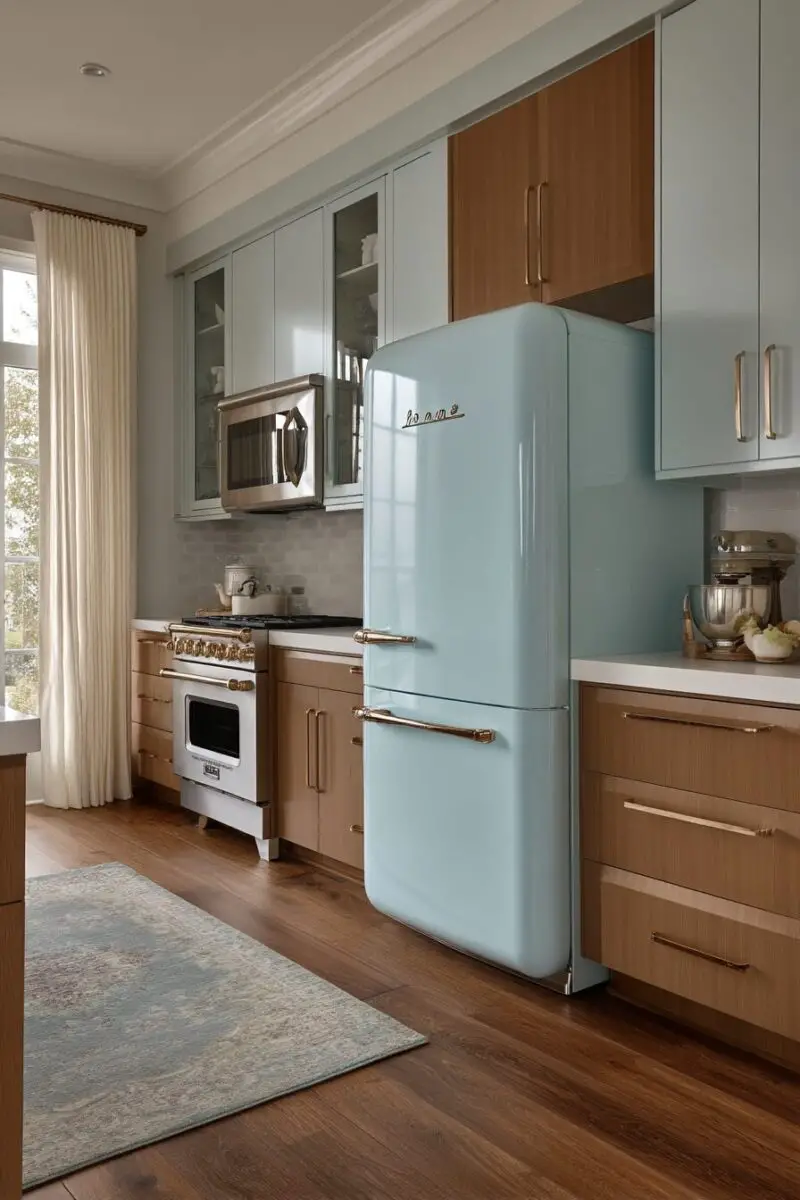
Who says you can’t have the best of both worlds in your country cottage kitchen?
Today’s vintage-inspired appliances capture the nostalgic aesthetic of yesteryear while offering all the conveniences of modern technology.
The cornerstone of this look is often a statement range in cream, pastel blue, or cherry red, featuring rounded edges and old-fashioned knobs that transport you straight to simpler times.
Brands like SMEG, Big Chill, and Elmira Stoveworks have perfected these retro-styled appliances that serve as functional art pieces in your cottage kitchen.
Look for refrigerators with curved corners and latching handles that mimic the iceboxes of the past while concealing modern features like water dispensers and smart technology.
For smaller appliances, seek out designs that harken back to the mid-century—kettles with wide bases and exaggerated spouts, toasters with chrome accents and rounded edges, and mixers in soft, muted colors that wouldn’t look out of place in your grandmother’s kitchen.
The beauty of these vintage-inspired pieces is how they create instant character without sacrificing performance—that charming coffee maker with the manual lever still brews your morning cup with programmable precision.
When incorporating these statement appliances, balance is key—let one or two larger pieces take center stage while keeping others in complementary colors that don’t compete for attention.
For authentic charm, seek out actual vintage small appliances that can be rewired for safety—a 1950s blender with its original glass jar or a restored waffle iron with bakelite handles adds irreplaceable character.
Don’t forget the details that tie these elements together—fabric-covered appliance cords, retro-styled digital clocks, and vintage kitchen timers complete the look while maintaining modern functionality.
The joy of vintage-inspired appliances extends beyond aesthetics—their sturdy construction and intuitive interfaces often create a more mindful cooking experience, slowing you down in the most delightful way.
Wooden Beams and Natural Textures That Ground the Space
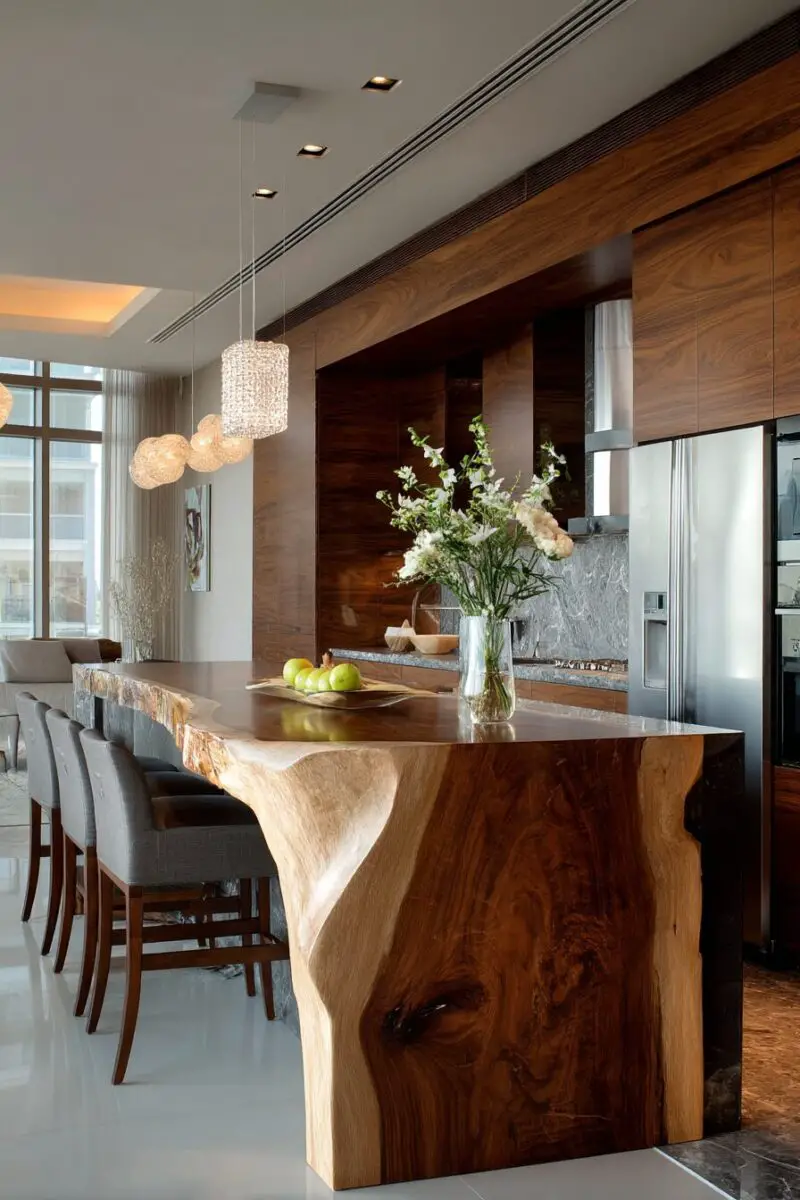
Nothing anchors a country cottage kitchen quite like the honest character of exposed wooden beams overhead.
These architectural elements instantly transport you to a simpler time, creating a framework that embraces everything beneath them with rustic warmth.
Whether your beams are authentic centuries-old timbers or newer wood crafted to look weathered, they establish an immediate connection to traditional craftsmanship and natural materials.
For maximum impact, consider cross-beams that create a subtle coffered effect, drawing the eye upward and making even modest-sized kitchens feel more expansive and interesting.
The beauty of wooden beams lies in their imperfections—knots, saw marks, and slight irregularities tell the story of the wood’s journey and add depth to your cottage aesthetic.
Complement these overhead features with natural textures throughout the space—butcher block countertops that develop a rich patina through years of use, woven basket storage that adds visual interest, and stone flooring that grounds the space with earthy permanence.
Tactile elements invite touch and create layers of sensory experience—consider adding a sisal or jute rug beneath your kitchen table, linen curtains that filter sunlight beautifully, or a collection of wooden cutting boards propped against the backsplash.
For authentic cottage charm, mix your natural materials rather than matching them perfectly—perhaps pair lighter pine beams with darker walnut countertops or weathered oak flooring with smooth soapstone work surfaces.
When incorporating multiple wood tones, unify them through shared undertones—warm, honey-colored pine works beautifully with rich cherry cabinetry when both share golden undertones.
Natural textures needn’t be limited to permanent features—woven placemats, pottery with visible clay texture, and hand-thrown ceramic dishes all contribute to the organic, collected-over-time feeling that defines country cottage style.
Remember that natural materials age gracefully—that water ring on your wooden table or slight wear on your stone countertop becomes part of the kitchen’s evolving story rather than a flaw to be corrected.
In spaces dominated by natural textures, consider softening acoustics with fabric elements—perhaps cushions on wooden chairs or a simple linen table runner—that absorb sound and make conversations around your cottage table all the more intimate and enjoyable.
✨Click to Get My 101 FREE Designer Room Ideas
The Perfect Breakfast Nook For Lingering Conversations
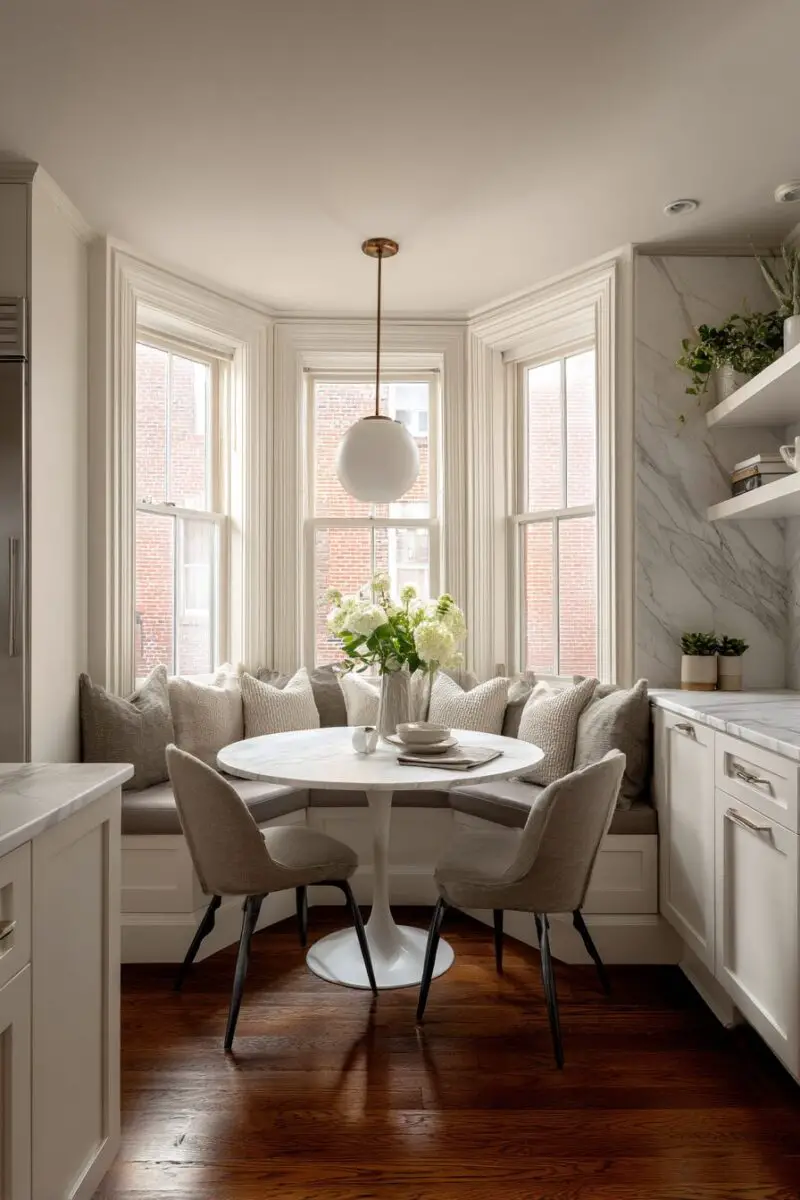
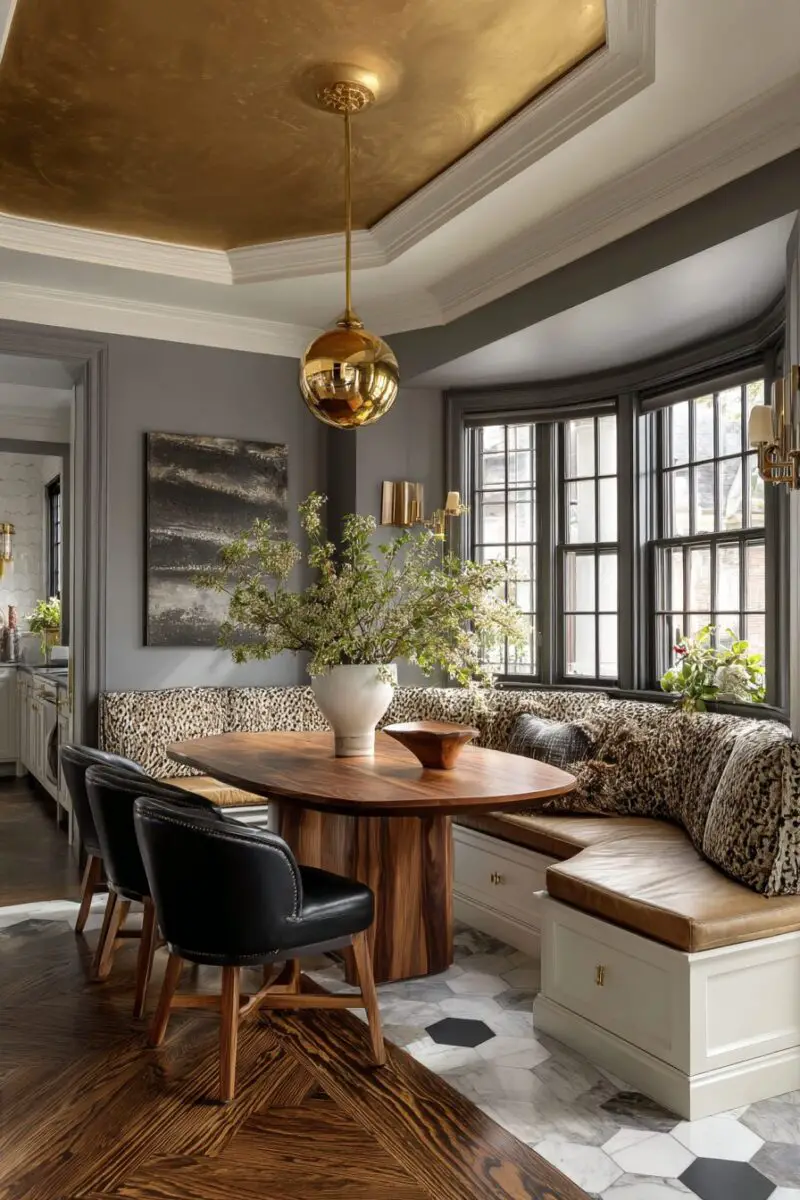
Every country cottage kitchen deserves that special corner where morning coffee stretches into afternoon conversations without anyone noticing the time.
The quintessential breakfast nook creates an invitation to pause—to savor both food and company in a setting that feels separate from the bustling cooking zone yet intimately connected to the heart of your home.
Begin with the right architecture—a recessed window bay provides the ideal framework, but any corner can transform into a nook with thoughtful furnishing and definition.
Built-in banquette seating maximizes space efficiency while creating that snug, enveloping feeling that encourages guests to settle in and stay awhile.
For authentic cottage charm, top your banquette with cushions in ticking stripes, subtle florals, or faded prints that suggest years of comfortable use and sunny afternoons.
The table in your breakfast nook should feel substantial but not overwhelming—consider a round pedestal style that facilitates conversation or a small rectangular farm table with turned legs and a planked top that bears the beautiful marks of family gatherings.
Lighting makes or breaks a breakfast nook—pendant fixtures hung low over the table create an intimate zone of illumination, while ensuring the light is warm rather than stark enhances that golden-hour feeling regardless of the time of day.
Window treatments for your nook should facilitate lingering—perhaps café curtains that filter light beautifully while maintaining privacy or simple roman shades that can adjust with the shifting sun.
Personal touches transform a breakfast nook from simply functional to memorably charming—hang a collection of family photos or botanical prints on adjacent walls, or install a small shelf for displaying treasured objects that spark conversation.
Storage integration elevates a basic nook to hardworking status—consider lift-top bench seating that conceals seasonal table linens or rarely-used serving pieces, maximizing function without sacrificing an inch of charm.
For year-round appeal, place your breakfast nook where it captures the best natural light—morning sun for early risers or western exposure for those who gather over evening tea and dessert.
Remember that the most inviting nooks embrace imperfection—slightly mismatched chairs, an antique table with visible repairs, or cushions that bear the gentle impression of those who’ve sat there before all contribute to that indefinable sense of cottage welcome that makes guests feel instantly at home.
Floral and Pastoral Patterns That Transport You to the Countryside
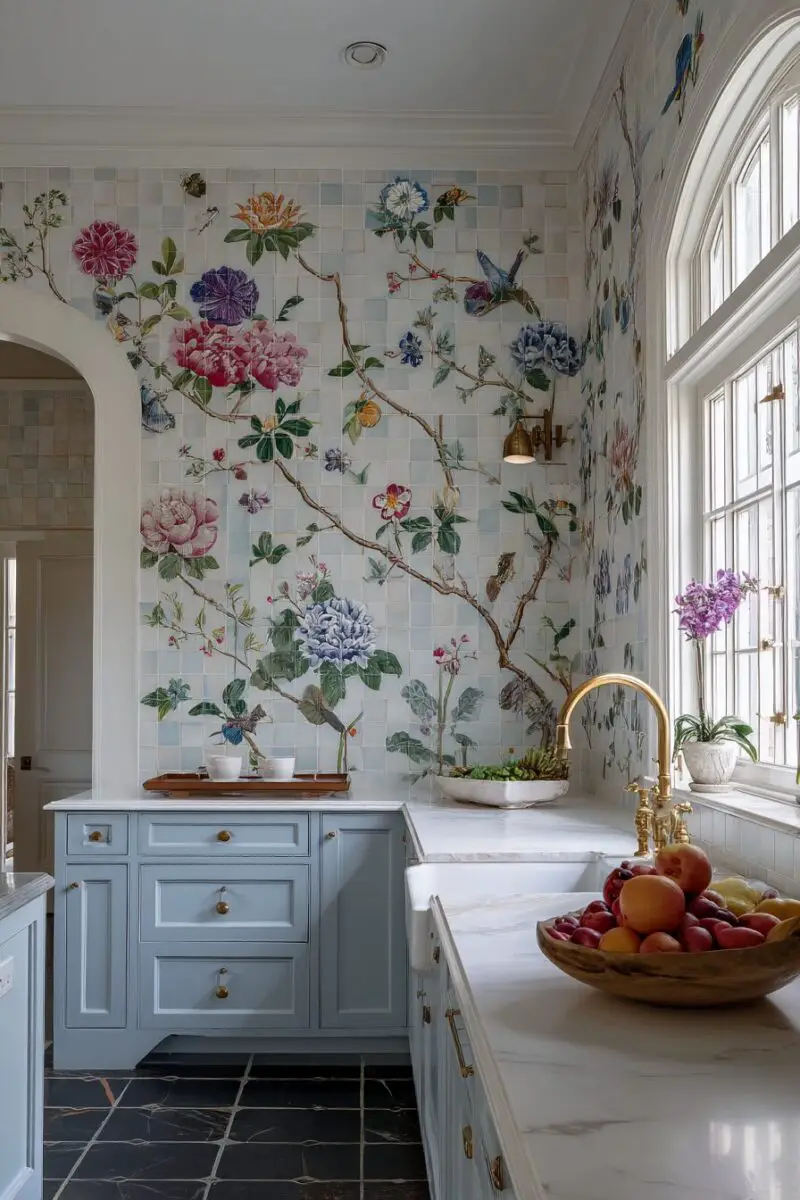
In country cottage kitchens, patterns do more than decorate—they weave stories of garden paths, meadow flowers, and pastoral landscapes directly into your daily environment.
The judicious use of florals, checks, and nature-inspired motifs creates that quintessential cottage feeling that balances nostalgia with timeless appeal.
Begin with window treatments as your pattern foundation—perhaps café curtains in a delicate wildflower print or roman shades featuring vintage-inspired botanical illustrations that filter sunlight into dappled patterns across your countertops.
Traditional gingham and buffalo checks in soft colorways like faded blue, gentle sage, or buttery yellow offer an instant cottage connection without overwhelming the space.
For authentic charm, consider mixing pattern scales within the same color family—perhaps smaller floral prints for tea towels alongside broader botanical motifs for chair cushions, united by shared hues that create harmony rather than visual chaos.
Wallpaper makes a triumphant return in cottage kitchens—consider installing it on a single focal wall or within the panels of glass-front cabinets for impact without overwhelming your space.
Look to historical patterns from designers like William Morris or vintage French provincial textiles for inspiration that feels both timeless and rooted in cottage tradition.
Remember that cottage patterns needn’t feel precious or formal—the most charming spaces incorporate designs that suggest comfortable use and casual gathering rather than pristine perfection.
Incorporate patterns through easy-to-change elements—tea towels hung from hooks, a collection of transferware plates displayed on open shelving, or seat cushions that can be recovered as seasons or preferences change.
For year-round appeal, consider how your patterns reflect the natural world beyond your windows—perhaps bird motifs that complement actual visitors to your garden feeders or botanical prints featuring the herbs growing on your windowsill.
In country kitchens, even utilitarian items become pattern opportunities—look for storage canisters with delicate designs, recipe boxes with floral decoupage, or vintage breadboards with pastoral scenes that serve both function and decorative purpose.
The most successful cottage kitchens use pattern as punctuation rather than overwhelming statement—allowing breathing room between design elements ensures your space feels collected and curated rather than chaotic or themed.
Antique and Repurposed Furniture With Stories to Tell
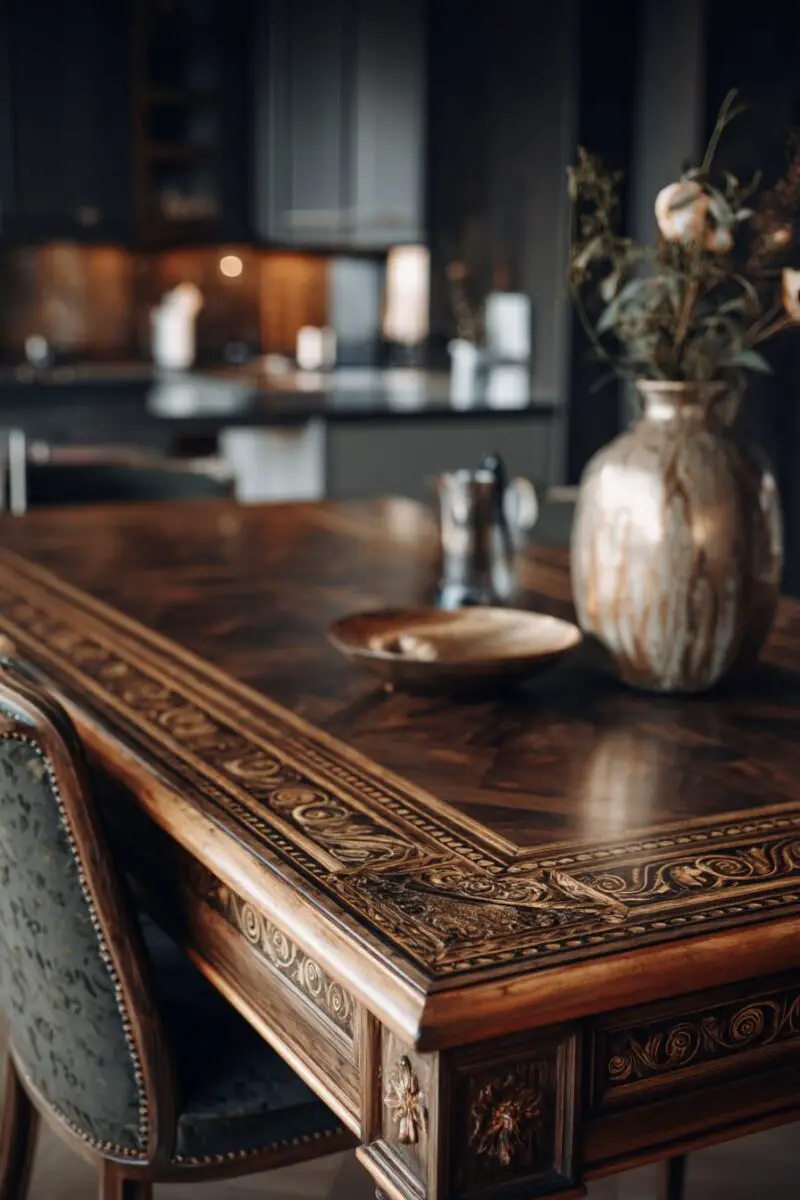
The country cottage kitchen celebrates history through furniture that brings its own narratives into your daily life.
Unlike matched kitchen sets from showrooms, these characterful pieces create a collected-over-time atmosphere that no catalog can replicate.
The cornerstone of this approach is often a substantial farmhouse table with a surface that bears witness to generations of family meals—knife marks, slight undulations, and subtle color variations make these pieces living documents of domestic history.
Look beyond traditional kitchen furniture to unexpected treasures—perhaps a Victorian washstand repurposed as a prep station, its original marble top perfect for pastry work, or a painted stepback cupboard that now displays your everyday dishes with casual elegance.
Library card catalogs find new purpose as spice storage, their tiny drawers perfectly sized for jars and packets while bringing unique architectural interest to your culinary space.
For authentic charm, seek out pieces with visible history—worn spots where hands have reached for handles year after year, gently sagging shelves that speak to the weight of objects lovingly placed and replaced, or repairs that tell stories of an item too precious to discard.
When incorporating antiques, balance is essential—anchor your kitchen with one or two significant pieces rather than filling every corner with collectibles that might overwhelm the functional aspects of the space.
Not every item needs pristine provenance—humble objects often bring the most genuine cottage feeling, like the three-legged stool pulled up to the counter for shell peas or the slightly wobbly side table that holds recipe books within easy reach.
For practical function with vintage appeal, consider how pieces can multitask—a painted hutch might store everyday dishes behind glass doors while its lower cabinets conceal modern small appliances, marrying charm with convenience.
The patina of well-loved wood deserves celebration rather than refinishing—that honey-colored glow that comes only from decades of gentle use and careful polishing cannot be manufactured or rushed.
When incorporating wooden antiques, create harmony through undertones rather than matching species—the warm amber of pine complements the deeper richness of walnut when both share golden rather than red undertones.
Remember that the most successful cottage kitchens balance reverence for the past with present-day comfort—that antique Windsor chair might need a small cushion to make lingering conversations possible, perfectly blending historical appreciation with practical enjoyment.
Warm Color Palettes That Welcome and Comfort

The colors of a country cottage kitchen speak directly to your emotions, creating an environment that feels instantly familiar and profoundly comforting before you’ve even settled in.
Unlike the cool crispness of contemporary spaces, cottage kitchens embrace warmth through thoughtfully layered color palettes drawn from nature’s most welcoming hues.
Begin with your foundation colors—consider walls in buttermilk cream, gentle sage green, or the softest terracotta that creates a backdrop of warmth without overwhelming the senses.
Cabinet colors for authentic cottage charm might include duck-egg blue, muted olive green, or weathered gray—tones that suggest the gentle fading that comes with years of sunlight rather than this season’s trending shade.
The magic of cottage color palettes lies in their complexity—these are not flat, stark colors but nuanced hues with depth that shifts subtly as light changes throughout the day.
For truly authentic cottage appeal, consider using milk paint or chalk paint on cabinetry and furniture—these traditional formulations create a depth and slight variation in color that no modern high-gloss finish can replicate.
When selecting countertop materials, warm-toned options like butcher block, soapstone with its subtle green undertones, or honed marble with gold veining contribute to the overall sense of welcoming comfort.
Backsplashes offer perfect opportunities for introducing color through handmade tiles with slight variations in tone—perhaps in butter yellow, faded blue, or soft green that complements rather than competes with your overall palette.
Remember that cottage kitchens traditionally evolved over time rather than being designed all at once—this gives you permission to incorporate beloved items regardless of whether they “match” perfectly, creating a more authentic and personally meaningful space.
Textiles contribute significantly to your color story—consider dish towels in faded stripes, chair cushions in subtle checks, or curtains in gentle florals that pull colors from throughout the room into one harmonious textile statement.
Metallic elements add essential warmth—replace modern chrome or stainless hardware with aged brass, copper, or bronze that develops a living patina and softly reflects light throughout your space.
The most successful cottage color schemes recognize that true warmth comes not from brightness but from depth and subtlety—colors that feel as though they’ve always been there, quietly supporting the life and memories created within these welcoming walls.
✨Click to Get My 101 FREE Designer Room Ideas
Kitchen Hearths & Wood-Burning Stoves That Create a Timeless Focal Point

Nothing captures the soul of a country cottage kitchen quite like the warm glow and gentle crackle of a traditional hearth or wood-burning stove anchoring the space.
These architectural elements aren’t just beautiful throwbacks to simpler times—they’re working features that provide physical warmth while creating an emotional center that draws family and guests like moths to flame.
For authentic cottage charm, consider a classic cast iron wood stove in deep black or rich enamel colors, its substantial presence immediately establishing your kitchen as a place of nurturing and comfort.
The beauty of a kitchen hearth extends beyond its obvious visual appeal—there’s something primally satisfying about cooking with flame, whether you’re simmering stews directly over embers or simply using the stove’s radiant heat to keep bread dough rising perfectly nearby.
In renovation projects, uncovering and restoring an original cooking fireplace transforms your kitchen instantly, connecting your modern life to the generations who cooked in the same spot centuries before.
For homes without existing hearths, today’s wood-burning cook stoves offer remarkable efficiency alongside vintage appeal—brands like Vermont Castings, Heartland, and AGA create pieces that function beautifully while serving as the visual anchor for your entire kitchen design.
When incorporating a hearth or stove, surrounding materials matter enormously—perhaps a backdrop of handmade tiles in subtle blues or greens, reclaimed brick that tells its own story of previous structures, or simply whitewashed stone that reflects light beautifully in the evening hours.
Safety considerations blend seamlessly with design in cottage kitchens—traditional features like copper heat shields not only protect nearby surfaces but develop a living patina that enhances the overall aesthetic.
Mixed Materials That Create Depth and Interest
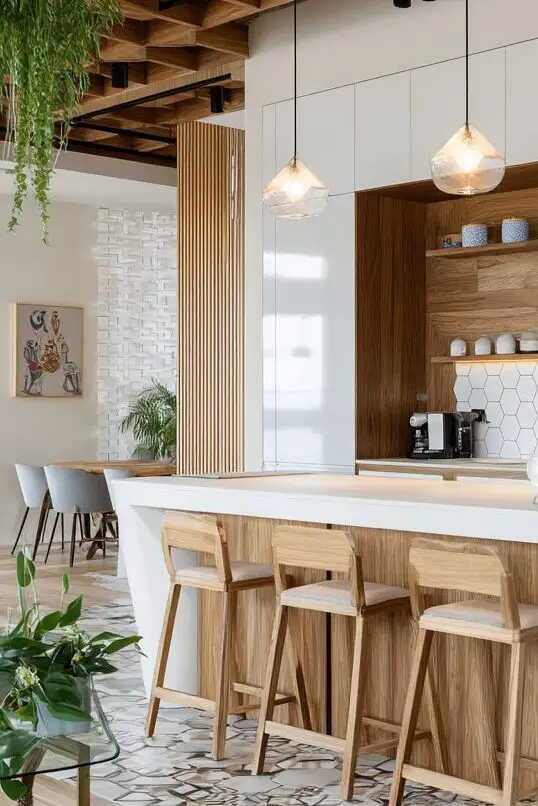
The country cottage kitchen celebrates the beautiful tension between different textures and surfaces, creating spaces with visual depth that invites both eye and hand to explore.
Unlike sleek, matched kitchens where materials create seamless transitions, the cottage aesthetic embraces gentle contrast through thoughtful material combinations that tell the story of evolution over time.
Begin with foundational contrasts—perhaps butcher block counters alongside a marble baking station, or smooth painted cabinetry against a roughly plastered wall that shows the gentle imperfections of handwork.
Flooring offers perfect opportunities for material interest—consider wide-plank pine boards that develop a honeyed patina over years of use, or handmade terra cotta tiles whose slight variations in color and size speak to their artisanal origins.
Metal elements add essential character—copper pots hanging from ceiling racks develop a living patina that changes subtly with use, while aged brass hardware warms to the touch after years of hands reaching for cabinet doors and drawers.
For authentic cottage charm, incorporate glass beyond standard windows—perhaps glass-fronted upper cabinets that display favorite dishes, vintage bottles lined along a windowsill, or a collection of mason jars that catch and refract light throughout the space.
Textile elements soften harder surfaces—consider linen curtains that filter sunlight beautifully, handwoven runners that protect wooden tables, or simple cotton dish towels hung from hooks that add both function and gentle color.
Stone brings permanent character—soapstone sinks develop a silky surface from years of use, limestone countertops bear witness to countless meals prepared with subtle staining that adds rather than detracts from their beauty.
Ceramics introduce essential handmade elements—everyday stoneware dishes stacked on open shelves, pottery canisters holding pantry staples, or hand-thrown bowls waiting to be filled with whatever the season offers.
For unexpected texture, consider incorporating wicker, rattan or seagrass through counter stools, basket storage, or even pendant light fixtures that cast interesting shadow patterns across walls and floors.
Remember that in cottage kitchens, perfect matching is never the goal—the slight variations between painted woodwork and ceramic tile, between woven textiles and smooth stone create the visual interest that makes these spaces endlessly fascinating rather than immediately comprehensible.
The true magic of mixed materials emerges over time—as surfaces age at different rates, developing their own unique patinas, your kitchen gains layers of character impossible to create through instant renovation, becoming instead a living document of your family’s life within these welcoming walls.
The most beloved country kitchens evolve gradually, collecting memories alongside mismatched teacups and well-worn wooden spoons.
If you incorporate just one of these ideas or embrace them all, the warmth and welcome of cottage style will transform your kitchen into the true heart of your home—a place where time slows down, conversations deepen, and the simple act of sharing food becomes a celebration of connection.
After all, in a world that often moves too quickly, creating a space that invites you to linger might be the greatest luxury of all.

